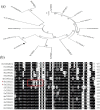The effects of promoter variations of the N-Methylcanadine 1-Hydroxylase (CYP82Y1) gene on the noscapine production in opium poppy
- PMID: 29563567
- PMCID: PMC5862900
- DOI: 10.1038/s41598-018-23351-0
The effects of promoter variations of the N-Methylcanadine 1-Hydroxylase (CYP82Y1) gene on the noscapine production in opium poppy
Abstract
Noscapine is an antitumor alkaloid produced in opium poppy (Papaver somniferum) and some members of the Papaveraceae family. It has been primarily used for its antitussive effects; more recently, its anticancer properties were shown. Herein, we detected an SSR embedded in the promoter region of the CYP82Y1 gene, which was found to be the first committed-step enzyme in the noscapine biosynthesis pathway, using the MISA program. Some collected ecotypes of P. somniferum were investigated for understanding of SSRs role in the regulation of gene expression and metabolite content. Quantitative PCR showed that a variation in the motif repeat number (either a decrease or increase) down-regulated the expression of the CYP82Y1 gene. Furthermore, the analysis of noscapine content suggested that a variation in the promoter region influence noscapine amount. Moreover, P. bracteatum was analyzed in both transcript and metabolite levels, and illustrated much less expression and metabolite level in comparison to P. somniferum. By exploiting the transcriptome data from the eight genera of the Papaveraceae family, we found that noscapine biosynthesis genes are present in P. bracteatum and are not shared in other genera of the Papaveraceae family. This results may explain production of a confined metabolite within a genus.
Conflict of interest statement
The authors declare no competing interests.
Figures





Similar articles
-
CYP82Y1 is N-methylcanadine 1-hydroxylase, a key noscapine biosynthetic enzyme in opium poppy.J Biol Chem. 2014 Jan 24;289(4):2013-26. doi: 10.1074/jbc.M113.505099. Epub 2013 Dec 9. J Biol Chem. 2014. PMID: 24324259 Free PMC article.
-
Characterization of three O-methyltransferases involved in noscapine biosynthesis in opium poppy.Plant Physiol. 2012 Jun;159(2):618-31. doi: 10.1104/pp.112.194886. Epub 2012 Apr 25. Plant Physiol. 2012. PMID: 22535422 Free PMC article.
-
Engineering of CYP82Y1, a cytochrome P450 monooxygenase: a key enzyme in noscapine biosynthesis in opium poppy.Biochem J. 2023 Dec 13;480(23):2009-2022. doi: 10.1042/BCJ20230243. Biochem J. 2023. PMID: 38063234
-
Benzylisoquinoline alkaloid biosynthesis in opium poppy.Planta. 2014 Jul;240(1):19-32. doi: 10.1007/s00425-014-2056-8. Epub 2014 Mar 27. Planta. 2014. PMID: 24671624 Review.
-
Noscapine comes of age.Phytochemistry. 2015 Mar;111:7-13. doi: 10.1016/j.phytochem.2014.09.008. Epub 2015 Jan 9. Phytochemistry. 2015. PMID: 25583437 Review.
Cited by
-
The effects of water deficit on the expression of monoterpene synthases and essential oils composition in Salvia ecotypes.Physiol Mol Biol Plants. 2020 Nov;26(11):2199-2207. doi: 10.1007/s12298-020-00892-1. Epub 2020 Nov 12. Physiol Mol Biol Plants. 2020. PMID: 33268923 Free PMC article.
-
Integrated Metabolome and Transcriptome Analysis in Ammi majus L. Revealed Candidate Genes of Furanocoumarins Pathway.Biochem Genet. 2025 Apr 24. doi: 10.1007/s10528-025-11111-5. Online ahead of print. Biochem Genet. 2025. PMID: 40272701
-
Toward understanding of the methoxylated flavonoid biosynthesis pathway in Dracocephalum kotschyi Boiss.Sci Rep. 2021 Oct 1;11(1):19549. doi: 10.1038/s41598-021-99066-6. Sci Rep. 2021. PMID: 34599246 Free PMC article.
-
Transcriptome Profiling of Two Ornamental and Medicinal Papaver Herbs.Int J Mol Sci. 2018 Oct 16;19(10):3192. doi: 10.3390/ijms19103192. Int J Mol Sci. 2018. PMID: 30332811 Free PMC article.
-
Identification and expression analysis of S-alk(en)yl-L-cysteine sulfoxide lyase isoform genes and determination of allicin contents in Allium species.PLoS One. 2020 Feb 24;15(2):e0228747. doi: 10.1371/journal.pone.0228747. eCollection 2020. PLoS One. 2020. PMID: 32092058 Free PMC article.
References
-
- Dewick PM. Medicinal natural products. United Kingdom: John Wiley & Sons, Ltd; 2009.
Publication types
MeSH terms
Substances
LinkOut - more resources
Full Text Sources
Other Literature Sources

